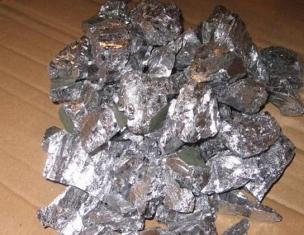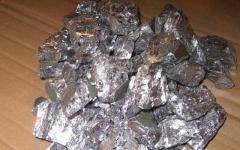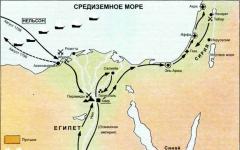How did the planets appear?
It would seem scientific and technological progress is able to give answers to many questions concerning the world around us. But scientists still have many mysteries and inaccuracies. After all, sometimes, even the most logical and coherent theory remains only at the level of assumptions, because there are simply no facts to support it, and sometimes it is extremely difficult to obtain evidence. How the planets came to be is one of those open questions, although there are quite a lot of theories and assumptions about this. Let's look at what hypotheses exist regarding the origin of planets.
Main scientific theory
Today there are many different scientific hypotheses, proving where the planets came from, however, in modern natural science adhere to the gas-dust cloud theory.
It lies in the fact that the solar system with all the planets, satellites, stars and others celestial bodies appeared due to compression of the gas and dust cloud. In its center the most big star- Sun. And all other bodies appeared from the Kuiper belt and the Oort cloud. If we talk in simple language, then the planets appeared as follows. There was some matter in space that consisted only of gas and dust dissolved in it. After strong exposure to atmospheric pressure, the gas began to compress, and the dust began to turn into large and heavy objects, which later became planets.
Kuiper Belt and Oort Cloud
We have already mentioned the Kuiper belt and the Oort cloud earlier. Scientists say that it was these two objects that became the building material from which the planets emerged.
The Kuiper Belt is a zone in the Solar System that begins from the orbit of Neptune. It is believed that this is an asteroid belt, but this is not entirely true. It is several times larger and more massive than it. In addition, the Kuiper belt differs from the asteroid belt in that it consists of volatile substances such as ammonia and water. Today it is believed that it was in this belt that three dwarf planets arose - Pluto, Huamea, Makemake, as well as their satellites.
The second object that contributed to the formation of planets, the Oort cloud, has not yet been found, and its existence has only been confirmed hypothetically. It is an internal and external cloud consisting of isotopes of carbon and nitrogen with solid bodies moving in it. It is believed that this is a certain spherical region of the solar system, which is the source of the emergence of comets, which are also the building material for the emergence of other planets. If you imagine how the planets appeared externally, then you can imagine how dust and other solids compressed, as a result of which they acquired the spherical shape in which we know them today.
Alternative scientific hypotheses
- So, the first of such researchers was Georges-Louis Buffon. In 1745, he suggested that all planets appeared as a result of the ejection of matter after the collision of the Sun with a passing comet. The comet broke up into many parts, which, under the influence of centrifugal and centripetal forces energy from the sun formed the planets solar system.
- A little later, in 1755, a researcher named Kant suggested that all planets were formed due to the fact that dust particles under the influence of gravity formed the planets.
- In 1706, French astronomer Pierre Laplace put forward his alternative theory of the appearance of planets. He believed that initially a huge hot nebula consisting of gas formed in space. It rotated slowly in outer space, but the centrifugal force increasing as a result of the movement was the basis for the emergence of planets. The planets appeared at certain points, which were located in rings left along the path. In total, Laplace said, 10 rings separated, which broke up into 9 planets and an asteroid belt.
- And in the 20th century, Fred Hoyle put forward his hypothesis about how the planets appeared. He believed that the Sun had a twin star. Fred argued that this star exploded, resulting in the formation of planets.
- But not only science tries to understand where the planets came from, religion also tries to explain this interesting question. So, there is the theory of creationism. It says that all space objects, including the planets of the solar system, were created by the creator, God.
And these are not all the hypotheses that exist today. If you want to see with your own eyes how the planets appeared, the video can be found on the Internet, as well as in some electronic manuals in astronomy.
We all live on planet Earth, I think each of us is interested in how our planet was formed. Scientists have hypotheses on this issue.
How did planet earth appear?
The earth was formed approximately 4.5 billion years ago. It is believed that this is the only planet in the Universe that is inhabited by living beings. Astronomy researchers claim that the Earth emerged from cosmic dust and gas that remained after the formation of the Sun. They also claim that the Earth was originally a molten mass without any life. But then water began to accumulate and the surface began to harden. Asteroids, comets and the energy of the Sun formed the relief and climate of the Earth that we know today.
If you are seriously interested in the question of how planet Earth came to be, a video that is quite easy to find will clearly tell you about this issue.
Now you know how the planets of the solar system appeared. Astronomers have not yet reached a consensus on this issue, but I would like to believe that the development of science and technology in the near future will allow us to collect evidence and say exactly how the planets appeared.
The history of our planet still holds many mysteries. Scientists from various fields of natural science have contributed to the study of the development of life on Earth.
Our planet is believed to be about 4.54 billion years old. This entire time period is usually divided into two main stages: Phanerozoic and Precambrian. These stages are called eons or eonothema. Eons, in turn, are divided into several periods, each of which is distinguished by a set of changes that occurred in the geological, biological, and atmospheric state of the planet.

- Precambrian, or cryptozoic is an eon (time period in the development of the Earth), covering about 3.8 billion years. That is, the Precambrian is the development of the planet from the moment of formation, the formation of the earth’s crust, the proto-ocean and the emergence of life on Earth. By the end of the Precambrian, highly organized organisms with a developed skeleton were already widespread on the planet.
The eon includes two more eonothems - catarchaean and archaean. The latter, in turn, includes 4 eras.

1. Katarhey- this is the time of the formation of the Earth, but there was no core or crust yet. The planet was still a cold cosmic body. Scientists suggest that during this period there was already water on Earth. The Catarchaean lasted about 600 million years.
2. Archaea covers a period of 1.5 billion years. During this period, there was no oxygen on Earth yet, and deposits of sulfur, iron, graphite, and nickel were being formed. The hydrosphere and atmosphere were a single vapor-gas shell that enveloped the globe in a dense cloud. The sun's rays practically did not penetrate through this curtain, so darkness reigned on the planet. 2.1 2.1. Eoarchaean- This is the first geological era, which lasted about 400 million years. The most important event of the Eoarchean was the formation of the hydrosphere. But there was still little water, the reservoirs existed separately from each other and did not yet merge into the world ocean. At the same time earth's crust becomes solid, although asteroids are still bombarding the Earth. At the end of the Eoarchean, the first supercontinent in the history of the planet, Vaalbara, formed.
2.2 Paleoarchean- the next era, which also lasted approximately 400 million years. During this period, the Earth's core is formed, tension increases magnetic field. A day on the planet lasted only 15 hours. But the oxygen content in the atmosphere increases due to the activity of emerging bacteria. Remains of these first forms of Paleoarchean life have been found in Western Australia.
2.3 Mesoarchean also lasted about 400 million years. During the Mesoarchean era, our planet was covered by a shallow ocean. The land areas were small volcanic islands. But already during this period the formation of the lithosphere begins and the mechanism of plate tectonics starts. At the end of the Mesoarchean, the first ice age occurs, during which snow and ice first formed on Earth. Biological species are still represented by bacteria and microbial life forms.
2.4 Neoarchaean- the final era of the Archean eon, the duration of which is about 300 million years. Colonies of bacteria at this time form the first stromatolites (limestone deposits) on Earth. The most important event of the Neoarchean was the formation of oxygen photosynthesis.

II. Proterozoic- one of the longest time periods in the history of the Earth, which is usually divided into three eras. First appears during the Proterozoic ozone layer, the world ocean reaches almost its modern volume. And after the long Huronian glaciation, the first multicellular life forms appeared on Earth - mushrooms and sponges. The Proterozoic is usually divided into three eras, each of which contained several periods.
3.1 Paleo-Proterozoic- the first era of the Proterozoic, which began 2.5 billion years ago. At this time, the lithosphere is fully formed. But the previous forms of life practically died out due to an increase in oxygen content. This period was called oxygen catastrophe. By the end of the era, the first eukaryotes appear on Earth.
3.2 Meso-Proterozoic lasted approximately 600 million years. The most important events of this era: the formation of continental masses, the formation of the supercontinent Rodinia and the evolution of sexual reproduction.
3.3 Neo-Proterozoic. During this era, Rodinia breaks up into approximately 8 parts, the superocean of Mirovia ceases to exist, and at the end of the era, the Earth is covered with ice almost to the equator. In the Neoproterozoic era, living organisms for the first time began to acquire hard shell, which will later serve as the basis of the skeleton.

III. Paleozoic- the first era of the Phanerozoic eon, which began approximately 541 million years ago and lasted about 289 million years. This is the era of emergence ancient life. The supercontinent Gondwana unites the southern continents, a little later the rest of the land joins it and Pangea appears. Climatic zones begin to form, and the flora and fauna are represented mainly by marine species. Only towards the end of the Paleozoic did land development begin and the first vertebrates appeared.
The Paleozoic era is conventionally divided into 6 periods.
1. Cambrian period lasted 56 million years. During this period, the main rocks are formed, and a mineral skeleton appears in living organisms. And the most important event of the Cambrian is the emergence of the first arthropods.
2. Ordovician period- the second period of the Paleozoic, which lasted 42 million years. This is the era of the formation of sedimentary rocks, phosphorites and oil shale. The organic world of the Ordovician is represented by marine invertebrates and blue-green algae.
3. Silurian period covers the next 24 million years. At this time, almost 60% of living organisms that existed before die out. But the first cartilaginous and bony fishes in the history of the planet appear. On land, the Silurian is marked by the appearance of vascular plants. Supercontinents are moving closer together and forming Laurasia. By the end of the period, ice melted, sea levels rose, and the climate became milder.

4. Devonian period characterized by rapid development various forms life and development of new ecological niches. The Devonian covers a time period of 60 million years. The first terrestrial vertebrates, spiders, and insects appear. Sushi animals develop lungs. Although, fish still predominate. The flora kingdom of this period is represented by propferns, horsetails, mosses and gosperms.
5. Carboniferous period often called carbon. At this time, Laurasia collides with Gondwana and a new supercontinent Pangea appears. A new ocean is also formed - Tethys. This is the time of the appearance of the first amphibians and reptiles.

6. Permian period- the last period of the Paleozoic, ending 252 million years ago. It is believed that at this time it fell to Earth large asteroid, which led to significant climate change and the extinction of almost 90% of all living organisms. Most of the land is covered with sand, and the most extensive deserts appear that have ever existed in the entire history of the development of the Earth.

IV. Mesozoic- the second era of the Phanerozoic eon, which lasted almost 186 million years. At this time, the continents acquired almost modern outlines. A warm climate contributes to the rapid development of life on Earth. Giant ferns are disappearing and are being replaced by angiosperms. The Mesozoic is the era of dinosaurs and the appearance of the first mammals.
The Mesozoic era is divided into three periods: Triassic, Jurassic and Cretaceous.
1. Triassic period lasted just over 50 million years. At this time, Pangea begins to break apart, and the internal seas gradually become smaller and dry out. The climate is mild, the zones are not clearly defined. Almost half of the land's plants are disappearing as deserts spread. And in the kingdom of fauna the first warm-blooded and land reptiles appeared, which became the ancestors of dinosaurs and birds.

2. Jurassic period
covers a span of 56 million years. The Earth had a humid and warm climate. The land is covered with thickets of ferns, pines, palms, and cypresses. Dinosaurs reign on the planet, and numerous mammals were still distinguished by their small stature and thick hair.

3. Cretaceous period- the longest period of the Mesozoic, lasting almost 79 million years. The split of the continents is almost over, Atlantic Ocean significantly increases in volume, ice covers form at the poles. Increase water mass oceans leads to the formation of the greenhouse effect. At the end of the Cretaceous period, a catastrophe occurs, the causes of which are still not clear. As a result, all dinosaurs and most species of reptiles and gymnosperms became extinct.

V. Cenozoic- this is the era of animals and homo sapiens, which began 66 million years ago. The continents at this time acquired their modern shape, Antarctica occupied South Pole The lands and oceans continued to expand. Plants and animals that survived the disaster of the Cretaceous period found themselves in a completely new world. Unique communities of life forms began to form on each continent.
The Cenozoic era is divided into three periods: Paleogene, Neogene and Quaternary.

1. Paleogene period ended approximately 23 million years ago. At this time, a tropical climate reigned on Earth, Europe was hidden under evergreen tropical forests, only deciduous trees grew in the north of the continents. It was during the Paleogene period that mammals developed rapidly.

2. Neogene period covers the next 20 million years of the planet's development. Whales and bats appear. And, although saber-toothed tigers and mastodons still roam the earth, the fauna is increasingly acquiring modern features.

3. Quaternary period began more than 2.5 million years ago and continues to this day. Two most important events characterize this time period: the ice age and the appearance of man. The Ice Age completely completed the formation of the climate, flora and fauna of the continents. And the appearance of man marked the beginning of civilization.
Now we have reached our planet.
How was the Earth actually formed? While we, the people living on this planet, are not ready to talk about it. We can measure and understand the size of the oceans and continents on our planet, how much time it takes to fly somewhere by plane. Yes, we have some idea about the planet of the solar system - Earth, although it is far from complete. The same questions arise - when, where and for what purposes?
I have previously expressed a hypothesis that our planet Earth may have been located in a different constellation and was a satellite of a completely different star (a source of thermal radiation). It was inhabited and there were humanoid and other creatures of gigantic size on it. Why giant? This is explained by only one factor, what kind of star and what energy it gives, that is, the closer to the source of magnetic energy, the larger the size of the flora and fauna will be. And of course, again there is a dependence on the state of the planet itself, or rather its atmosphere.
Therefore, all the found skeletons of 10-20 meter people and various lizards belonged to a different era of life on Earth and not during our solar luminary. It is difficult to say what kind of civilization they had. At some point (apparently, there were good reasons for this) something terrible happened to this planet and all living beings were doomed to death. After this, this planet could simply turn into a large meteorite. But in view of the fact that this planet was unique in its internal reserves, kind beyond beings decided to preserve it.

To do this, they created a new magnetic body, our Sun (possibly on the outskirts of the Universe) and moved our planet to this place. Personally, I don’t see anything supernatural in this. Simply, for this it was necessary to install magnetic installations on the planet that could create traction acceleration in the designated direction. Of course, it was necessary to constantly correct this direction. Approximately such a spotter could be the small planet that we now call the Moon. We humans cannot imagine such possibilities. And for super beings, this is a difficult relocation of the planet, perhaps the same as we move heavy vehicles, say, across the Sahara Desert. Maybe the example is not very successful, but again we do not know the development of the technical intelligence of aliens.
Then it is possible to at least somehow explain the existence of a long ice age on our planet. Imagine a long journey through dark and cold space, and after that, a long thawing of the planet. Even those who remained on the planet at that moment were subject to sudden freezing and their bodies, like the entire surface of the planet, were covered with a multi-meter layer of ice. And this happened not for a hundred or 50 years, but more.
You can object to such a hypothesis, but no one can refute it.
And of course, the next point of intelligent beings, after installing the planet in the orbit of the Sun, is the new creation of life on the planet. But how to revive an extinct planet and create life anew?
We humanity had only one justification for the formation of planet Earth - this is the gradual collision of solid cosmic objects and gases, which over a long period various reactions, shaped our planet. I also cannot refute this, although I think it is stupid. I just can’t understand - small asteroids fought, destroyed and fought again. As soon as a small ball has been created, it is again destroyed by incoming asteroids. But then, let me ask, who and how lit a “fire” in the center of the planet, so that it would become warm, and subsequently, from this warmth, our earthly atmosphere would be created? As you understand, our Sun alone would not be able to do this.
Have you ever wondered where the incomprehensible magma came from, why it has such enormous temperatures, while our Earth does not heat up and even freezes in places? What is this magma core for? Many questions arise again.
After a general overview, allow me to express my hypothesis about the formation of our beloved planet. Our planet Earth has been moved in outer space.

"Traditional" structure of the Earth
At the same time, the necessary conditions had already been created, i.e. Our Sun was originally made. After moving, our planet is “placed” in the desired orbit in relation to the Sun. Now, it had to be heated from the inside to create life on this planet.
Again, without knowledge of chemistry and physics that is extremely incomprehensible to us, this is not possible.
Let's turn to simple school physics. Just compare all the lines coming from two permanent magnets. Is there a difference between such lines of our Earth and laboratory magnets. As you can see - none. All lines go from S to N. And then return along arcs. These are our laws, and dogma for us in the field of permanent magnets.
It turns out that in the center of our planet there are the same permanent magnets or magnetic installations. Then it turns out that someone dug through our planet from the poles and specially installed such magnets (magnetic installations). This is very difficult to do, according to our concepts, but quite easy for intelligent beings to do. With such knowledge in the technical field, there will not be much work.
Having launched such magnetic installations into action, precisely along the axis of our globe on both sides, intelligent beings made a through tunnel. And then, using the same two magnetic devices, directing rays of magnetic energy towards each other (with different vortices of magnetic spirals), they created a reaction (as we understand thermonuclear), which has been working for many centuries. Believe me, I imagine the power of such attitudes, it’s elementary. Just contact, again, the media. According to them, huge round openings were found on the surface of our planet, which were made not a hundred years ago, but in our time. It’s just that these intelligent beings ask you to believe that this is possible. And we have no idea what kind of tunnels there might be inside the planet.
We, humanity, have not yet begun to explore the internal cavities of our planet. For now, we're just drilling it from all sides. I can even assume that the intelligent beings who produced us have already taken care of the worst consequences that can happen on the surface (the extinction of the sun, thermonuclear and various wars on the planet). Or maybe there, in the bowels of the Earth, there already exist huge underground galleries, where further residence of earthly humanity is possible.
Planet Earth is the only known place where life has been found so far, I say for now because perhaps in the future people will discover another planet or satellite with intelligent life living there, but for now Earth is the only place where there is life. Life on our planet is very diverse, from microscopic organisms to huge animals, plants and more. And people have always had the question - How and where did our planet come from? There are many hypotheses. Hypotheses for the origin of the Earth are radically different from each other, and some of them are very difficult to believe.
This is a very difficult question. You cannot look into the past and see how it all began and how it all began to emerge. The first hypotheses of the origin of planet Earth began to appear in the 17th century, when people had already accumulated a sufficient amount of knowledge about space, our planet and the solar system itself. Now we adhere to two possible hypotheses for the origin of the Earth: Scientific - The Earth was formed from dust and gases. Then the Earth was a dangerous place to live after many years of evolution, the surface of the planet Earth became suitable for our life: the Earth's atmosphere is breathable, a solid surface, and much more. And Religious - God created the Earth in 7 days and settled here all the diversity of animals and plants. But at that time, knowledge was not enough to weed out all other hypotheses, and then there were much more of them:
- Georges Louis Leclerc Buffon. (1707–1788)
He made an assumption that no one would believe now. He suggested that the Earth could have been formed from a piece of the Sun, which was torn off by a certain comet that hit our star.
But this theory was refuted. Edmund Halley, an English astronomer, noticed that our solar system is visited by the same comet at intervals of several decades. Halley even managed to predict the next appearance of the comet. He also found that the comet changes its orbit a little each time, which means it does not have significant mass to tear off a “piece” from the Sun.
- Immanuel Kant. (1724–1804)
Our Earth and the entire solar system were formed from a cold and collapsing dust cloud. Kant wrote an anonymous book where he described his hypotheses about the origin of the planet, but it did not attract the attention of scientists. Scientists by this time were considering a more popular hypothesis put forward by Pierre Laplace, a French mathematician.
- Pierre-Simon Laplace (1749–1827)
Laplace suggested that the solar system was formed from a constantly rotating gas cloud heated to enormous temperatures. This theory is very similar to current scientific theory.
- James Jeans (1877–1946)
A certain cosmic body, namely a star, passed too close to our Sun. The sun's gravity tore some mass out of this star, forming a sleeve of hot material that eventually formed all of our 9 planets. Jeans spoke about his hypothesis so convincingly that in a short time it won the minds of people and they believed that this was the only possible emergence of the planet.
So, we looked at the most famous hypotheses of the origin, they were very unusual and diverse. In our time, they would not even listen to such people, because we now have much more knowledge about our solar system and about the Earth than people knew then. Therefore, hypotheses about the origin of the Earth were based only on the imagination of scientists. Now we can observe and conduct various studies and experiments, but this has not given us a definitive answer about how and from what exactly our planet originated.
This is a very difficult question. And it is hardly possible to give an exhaustive answer to it. At least for now. The Earth itself preserves its past, but there is no one to tell about this past - it was so long ago.
Scientists are slowly “questioning” the Earth through the study of radioactive rocks and are getting some answers. But the known past of the Earth is not final, but goes into an even more distant past - what happened before it solidified? Scientists compare planets to each other in their current state and try to judge from them the evolution of the Earth. Understanding the world is a long and not so easy process.
There are many hypotheses about the origin of the Earth and other planets, some of which we will consider separately on our website.
Modern hypotheses about the origin of the solar system must take into account not only mechanical characteristics Solar system, but also take into account numerous physical data on the structure of the planets and the Sun.
In the field of cosmogony, a stubborn ideological struggle has constantly been and is being waged, since the worldview of scientists is sharply affected here. Proponents of the theory of creationism, for example, believe that the age of the Earth is no more than 10,000 years, and supporters of the theory of evolution measure the age of the Earth in billions of years.

Thus, there is not yet a hypothesis that answers all questions about the origin of the Earth and other planets of the solar system. But scientists increasingly agree that the Sun and the planets were formed simultaneously (or almost simultaneously) from a single material medium, from a single cloud of gas and dust.
There are the following hypotheses about the origin of the planets of the solar system (including the Earth): the hypothesis of Laplace, Kant, Schmidt, Buffon, Hoyle, etc.
Basic modern scientific theory
The emergence of the Solar System began with the gravitational compression of a gas and dust cloud, in the center of which the most massive body, the Sun, was formed. The matter of the protoplanetary disk gathered into small planetesimals, which collided with each other and formed planets. Some planetesimals were ejected from the inner regions into the Kuiper Belt and the Oort cloud.
Kuiper Belt- the region of the Solar System from the orbit of Neptune to a distance of about 55 AU. e. from the Sun. Although the Kuiper Belt is similar to the asteroid belt, it is about 20 times wider and more massive than the latter. Like the asteroid belt, it consists mainly of small bodies, that is, material left over from the formation of the Solar System. Unlike asteroid belt objects, which are primarily composed of rocks and metals, Kuiper belt objects are composed primarily of volatile substances (called ices) such as methane, ammonia, and water. This region of near space contains at least three dwarf planets: Pluto, Haumea and Makemake. It is believed that some of the satellites of the planets of the solar system (Neptune's satellite Triton and Saturn's satellite Phoebe) also arose in this area.
Oort cloud- a hypothetical spherical region of the Solar System that serves as a source of long-period comets. The existence of the Oort cloud has not been instrumentally confirmed, but many indirect facts indicate its existence.
The Earth formed about 4.54 billion years ago from the solar nebula. Volcanic degassing created the primary atmosphere on earth was created as a result of volcanic activity, but it had almost no oxygen, it would have been toxic and not suitable for life. Much of the Earth was molten due to active volcanism and frequent collisions with other space objects. One of these large impacts is believed to have caused the tilt earth's axis and the formation of the Moon. Over time, such cosmic bombardment ceased, allowing the planet to cool and form a solid crust. The water delivered to the planet by comets and asteroids condensed into clouds and oceans. The earth finally became hospitable to life, and its earliest forms enriched the atmosphere with oxygen. For at least the first billion years, life on Earth took small and microscopic forms. Well, then the process of evolution began.
As we said earlier, there is no consensus on this matter. Therefore, hypotheses about the origin of the Earth and other planets of the solar system continue to arise, and old ones also exist.

J. Buffon's hypothesis
Not all scientists agreed with the evolutionary scenario for the origin of the planets. Back in the 18th century, the French naturalist Georges Buffon expressed a hypothesis, supported and developed by the American physicists Chamberlain and Multon. The hypothesis is this: once upon a time another star flew in the vicinity of the Sun. Its gravity caused a huge tidal wave on the Sun, stretching in space for hundreds of millions of kilometers. Having broken away, this wave began to swirl around the Sun and disintegrate into clumps, each of which formed its own planet.
F. Hoyle's conjecture
The English astrophysicist Fred Hoyle proposed another hypothesis in the 20th century: the Sun had a twin star that exploded. Most of the fragments were carried away into outer space, the smaller one remained in the orbit of the Sun and formed planets.
Creation theory
Creationism- theological and ideological concept, according to which the main forms organic world(life), humanity, planet Earth, as well as the world as a whole, are viewed as directly created by the Creator, or God. The term "creationism" became popular around late XIX centuries, meaning concepts that recognize the truth of the story of the creation of the world set forth in the Old Testament. It should be noted that there are several directions in the theory of creationism itself, but, for example, Templeton Prize-winning geneticist, evolutionist and former Dominican Catholic priest Francisco Ayala believes that there are no significant contradictions between Christianity and evolutionary theory, and evolutionary theory, on the contrary, helps to explain both the perfection of the world created by God and the cause of evil in the world.

Protodeacon A. Kuraev in the book “Orthodoxy and Evolution” he writes: “Those who vaguely think that God becomes unnecessary if we extend the process of creation are naive. Equally naive are those who believe that the creation of the world in more than six days diminishes the greatness of the Creator. It is only important for us to remember that nothing interfered or limited creative action. Everything happened according to the will of the Creator. But whether this will was to create the world instantly, or in six days, or in six thousand years, or in myriads of centuries, we do not know.”








